|
Ospringe Street
Ospringe
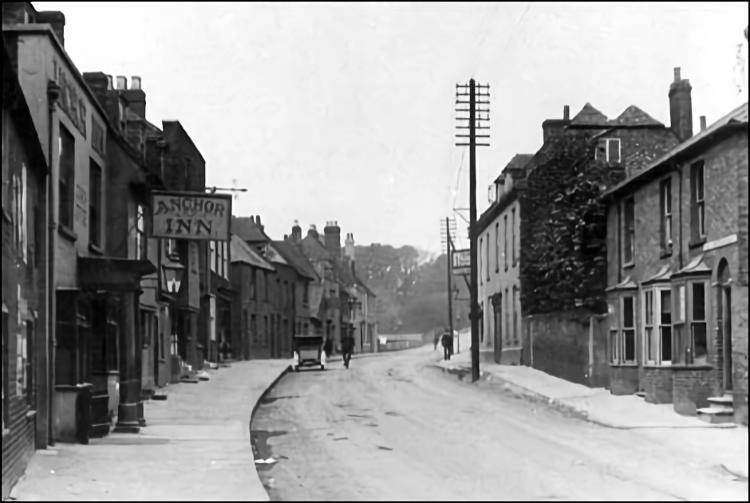
Above photo circa 1900. |

Above postcard, date unknown. |
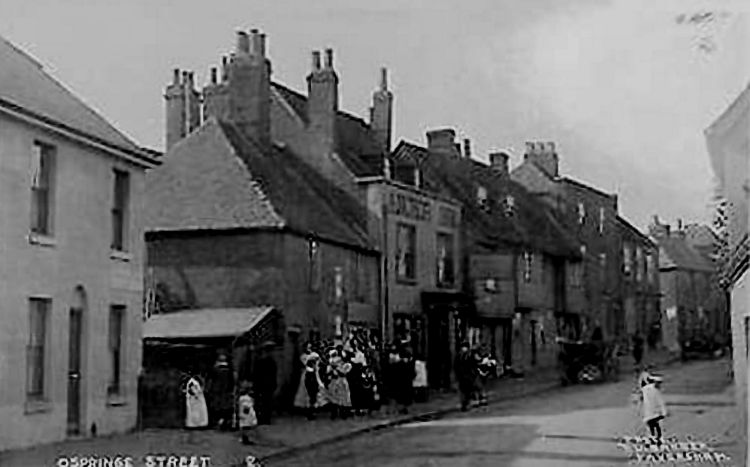
Above postcard, date unknown. |

Above photo 1910 showing a charabanc outing from the pub. |

Above postcard, date unknown. |
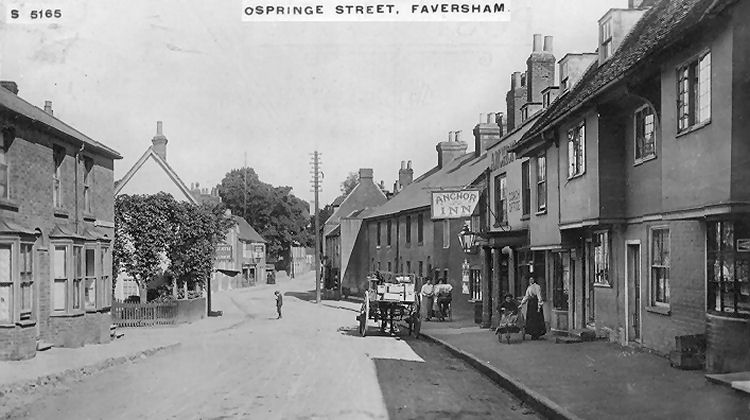
Above postcard, postmarked 1915. Kindly sent by Rory Kehoe. |
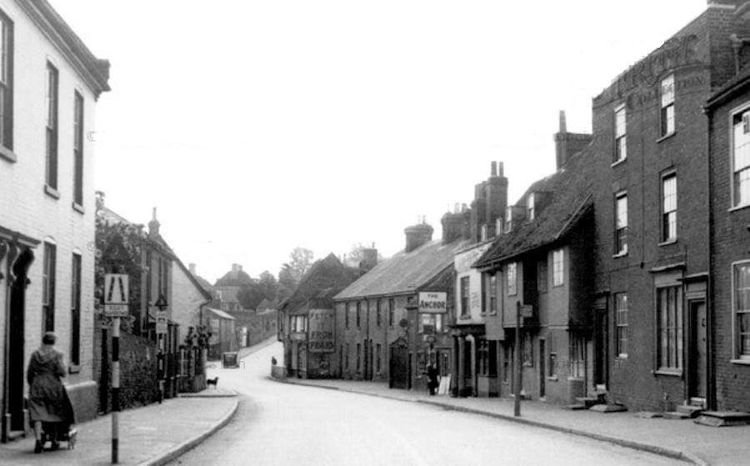
Above photo, date unknown. |
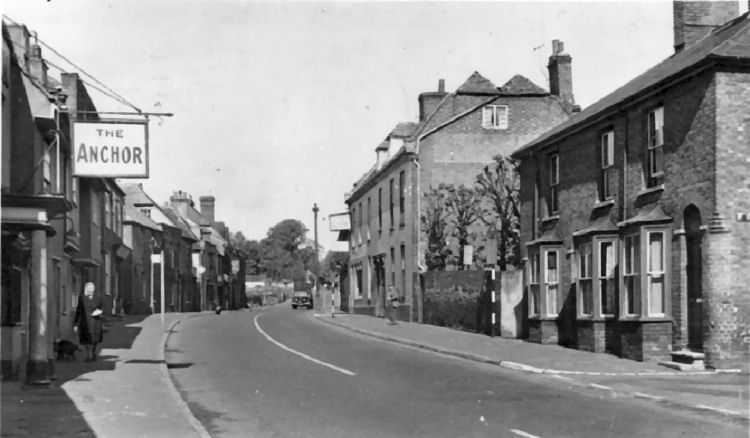
Above postcard, circa 1954, kindly sent by Rory Kehoe. |
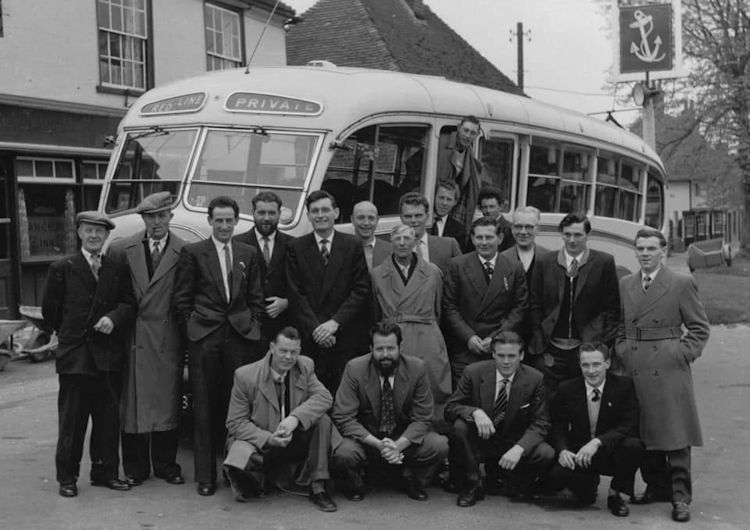
Above outing, 1950s. |
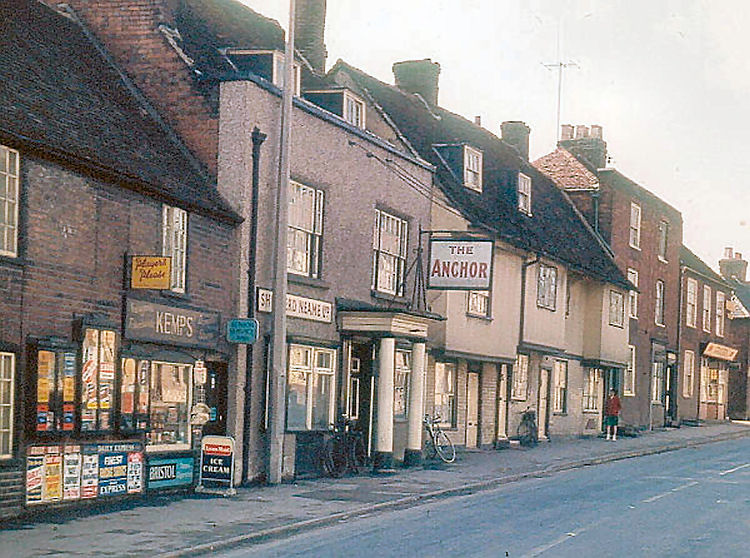
Above photo, 1965, by Arthur Percival. |

Above Google image, August 2016. |
The "Anchor" was a busy coaching inn, and possesses a fine portico which
gives it a distinct air of elegance in the largely uninteresting Ospringe
Street. It was formerly the "Blue Anchor," but I do not know when the name
changed.
|
From the Kentish Gazette, 18 April 1778.
Monday last the gentlemen of Faversham held their second annual
auricula feast at Mr Petts the "Anchor," at Ospringe; where the first
prize was won by Mr. Hull, with Don Quixote; second by Mr. Baker with
Palmer's Globe; the third by Mr. Spradbrow with Palmer's Globe. There
was a middling show of flowers.
|
|
Kentish Gazette 29 December 1801.
E. Fordred, "Anchor Inn," Ospringe.
Returns thanks to the public for their late support.
Finding a report has been industriously circulated that she intended
quitting her present situation, she thinks it necessary to acquaint
them that she means to continue in the above inn, and hopes by
attention to merit their future favours.
She has laid in a good stock of wines and spirits. Good beds and
stabling.
|
|
From the Kentish Gazette, 22 August 1843.
FAVERSHAM. Daring Swindler.
On Wednesday last a person of gentlemanly appearance went to the
Commercial Room of the "Ship Inn," Faversham, where he took dinner and
wine, and requested cash for a cheque of £21 5s., which the waiter
obtained for him at the shop of Mr. Holmes, grocer, and handed it to the
supposed traveller, who shortly after disappeared without paying for his
dinner, &c,; and the cheque having been forwarded to London, where it
represented to be payable, proved fictitious. The swindler appeared to
be about 40 years of age, light complexion, short and very stout made,
and had on at the time dark green frock coat, white waistcoat, and fawn
colour striped trousers. He afterwards took tea at the "Anchor," Ospringe,
and proceeded in Conningsby’s van to Chatham. He is said to have been
franking his patronage on some tavern-keepers at Canterbury.
|
|
From the Kentish Gazette, 3 October 1843.
LOST,
ON Wednesday last, a Black and White wire hair RABBIT BEAGLE, with some
Tan about him, he has a very full eye, and answers to the name of
Topper.
Whoever will bring him to the "Anchor Inn," Ospringe, shall be
handsomely rewarded for their trouble.
|
|
Kentish Gazette, 28 April 1857.
OSPRINGE.
"Crown
(sic) and Anchor Inn."
The opening dinner took place at the above inn on Thursday, when
upwards of 30 gentlemen sat down to a dinner, served up with good
taste by the landlord, Mr. Abraham Sherwood. The dinner gave the
utmost satisfaction to those who were present, and all expressed a
wish that the meeting might be made an annual one. The wine was of
first-rate quality, and the dinner passed off with great eclat.
|
|
South Eastern Gazette, 25 December, 1860.
Sittingbourne.
Petty Sessions, Monday (Before E. Twopony, Esq., in the chair, Col.
Dixon Dyke, Rev. G. B. Moore, and W. Bland, Esq.)
The license of the "Anchor Inn," Ospringe was transferred from
Abraham Sherwood to Horace Hills, of Doddington.
|
|
From the Kentish Chronicle and General Advertiser, 1 February, 1862. Price 1 1/2d.
ANNUAL DINNER AT OSPRINGE.
The annual dinner of Messrs. Saxby, Brothers, iron merchants, of
Canterbury, look place at the “Anchor Inn,” Ospringe, on Wednesday Inst,
when between twenty and thirty of their customers - tradesmen of
Faversham, and the
Neighbourhood - partook of an excellent repast served up in first-rate
style by the host and hostess. The chair
was taken by Mr. Edmund Saxby, and the vice-chair was occupied by Mr. P.
B. Saxby. Some very social and
convivial hours were passed. |
|
From the Kentish Chronicle, 10 May, 1862.
FATAL ACCIDENT ON THE LONDON, CHATHAM, AND DOVER RAILWAY.
On Friday morning last a most awful and fatal accident occurred on the
London, Chatham, and Dover Railway, at Ospringe, about half a mile from
the Faversham Railway Station. It appears that the mail train left the
Victoria Station at 7.10 a.m. and arrived at Sittingbourne at 8.20,
where happily one of the officials of the line had business, and thus
his life, no doubt was saved. The train was telegraphed to Faversham
from Teynham, “all right;” but on its reaching Ospringe, by some
unaccountable means the train ran off the line, throwing the carriages
down an embankment upwards of 18 feet high. It appears that where the
accident occurred, there is a slight curve, about 200 feet from the
bridge leading to Faversham, and it is supposed that the coupling irons
attached to the first carriage adjoining the engine were broken, thus
precipitating the whole of the carriages over the embankment, leaving
the engine on the rails. The engine driver immediately blew the whistle
for assistance from Faversham, and the station master, Mr. Breeze, was
at the scene of the accident in a very short space of time, and
fortunately met with Mr. Spong, Surgeon, of Faversham, who rendered
every assistance to the dying and wounded. Fortunately there were but
few passengers in the train.
The first thing that drew their attention, was poor Mr. Plumb a
commercial traveller in the cloth line, who is well known in this city.
He was found on the embankment and shortly after expired in the arms of
those rendering assistance.
The next who was seen was Mr. Crockford, the chairman of the Board of
Guardians, at Rochester, who had a severe compound fracture of the
ankle, which will necessitate the amputation of the leg, which operation
was to be performed at the time of our reporter leaving Faversham. This
gentleman lies at the “Anchor Inn,” Ospringe.
Close to a second class carriage, which with the top entirely crushed
in, the lower port, with the wheels completely embedded in the earth,
lay William Harris, one of the Company’s servants. This unfortunate man
was ordered to come by the ordinary passengers’ train, and if he had
followed the advice tendered, would have saved his life. His ankles were
dislocated, and the thigh was broken, with several other concussions
death was nearly instantaneous.
Mr. Mapleston, the accountant to the Company, received severe internal
injuries. The last of the sufferers was a Mr. Thompson, a solicitor, (we
believe,) of Belfast. His wife had written to him to attend his son, now
on the continent, who lays dangerously ill. This gentleman, of small
stature, is dreadfully injured, his face being swollen double the size.
his left eye entirely knocked out, with a severe scalp wound, and other
injuries. This is the only passenger that has not been identified by
friends, at the time of our reporter leaving he seemed to be sinking
fast.
The break van, with two Guards, was not much injured, and the two
occupants escaped unhurt.
About 50 men were sent from London to clear away the debris and to
repair the line, which was completed in time for the 6.30 p.m. express
train to pass on the down line. One of the carriages rolled down the
embankment and broke through a wall 14 inches thick, into a garden in
the occupation of Mr. Clarke, of Ospringe, a distance of 20 feet from
the line. Too much praise cannot be given to Mr. Breeze, the station
master of Faversham, who rendered to the sufferers every attention and
accommodation that laid in his power.
An inquest was held last evening by Mr. Delasaux and adjourned.
|
|
From the Kentish Chronicle, 17 May, 1862.
THE FATAL ACCIDENT ON THE LONDON, CHATHAM, AND DOVER RAILWAY.
THE INQUEST ON THE BODIES.
On Wednesday morning, shortly before eleven o'clock, the county coroner,
Mr. Thomas Thorpe Delasaux, resumed his inquiry as to the cause of death
of James Stratton Plumb (commercial traveller) and William Harris
(storekeeper in the service of the company), whose deaths had resulted
from injuries received at the accident at Ospringe, on the London,
Chatham, and Dover line, on the previous Friday. The inquest-room at the
“Anchor Inn,” Faversham, was crowded throughout the inquiry, and the
greatest possible interest was manifested in the proceedings.
Mr. E. Round, of the Inner Temple, instructed by Messrs. Freshfield and
Newman, in conjunction with Mr. S. G. Johnson, of Faversham, appeared
for the London, Chatham, and Dover Railway Company. There were also
present Messrs. Cobb and Hilton (directors). Mr. J. Cubitt (consulting
engineer). Mr. Mills (resident engineer), Mr. Forbes (general manager).
Mr. Markey (locomotive engineer), Mr. T. Hull (on behalf of the
contractors), Mr. Bishop, and other officials of the company.
Mr. Marsden (of Friday-Street; appeared for the relatives of the
deceased Plumb, with Messrs. Bathurst and Phillips; and Mr. Arnold (of
Rochester) for the family of Mr. Crockford (deceased).
Mr. W. Noah Spong, surgeon, of Faversham, said:— On Friday morning last
I attended the deceased about nine o'clock, The deceased Plum was lying
on the embankment of the London, Chatham, and Dover Railway. I examined
him and found injuries on the head, face, and neck, and a fractured left
thigh. He was dead when I first saw him. These injuries were the cause
of his death.
Matthew Simpson, of London, engine-driver, in the service of the
company, deposed:— At ten minutes past seven on Friday morning last I
left the Victoria station in charge of the express mail train, which
consisted of the engine and tender, two first and two second class
carriages, and a break-van, belonging to the London, Chatham, and Dover
Railway Company, in whose employ I am, and have been so nearly eleven
months. I do not know the number of passengers. Nothing unusual occurred
until the accident happened on reaching Ospringe. I observed that the
rails were in a bad state on the off side. The rails were out of order,
that is they were not in their proper position. I cannot say what caused
the rails to be in that state. The engine and tender left the rails, and
the next thing I saw was the carriages going down the embankment on the
near side of the line. The cause of the engine leaving the line was the
crooked state of the rails. I could do nothing to prevent the accident.
I rendered all the assistance in my power to the injured persons. I
found the deceased Mr. Plumb on the embankment, and also the other
deceased, Mr. Harris, who was sitting on the bank. I cannot throw any
more light on the occurrence .The average rate of the mail train is
about 40 miles an hour. At the time of the accident we were travelling
at the rate of 30 miles an hour, having slackened the speed for the
gates on that part of the line. The rails were in a slippery state, and
therefore the train was slackened.
I was about 30 yards from where the accident happened, when I observed
the defective state of the rails. I had no time to try to stop the train
then. I have been an engine driver 17 years.
By Colonel Yolland:— I was riding on the left side of the engine when I
observed the defective state of the rails. The line curves to the left.
The rails were bulged on the right side—they were curved outwards. I
think I was somewhere about the points leading to the gravel pit when I
first noticed the defects in the rails. Cannot say for what distance the
off rail was out of its right proper curve, but it was sufficient to
cause danger. I cannot say whether the engine dropped on the left or
right side. All the wheels of the engine had been off, but I cannot say
that they were all off at the same time. The auxiliary distance signal
can be seen shortly after leaving the cutting, not quite half a mile.
Robert Crumby, stoker, confirmed this evidence.
Charles Henry Benham, head guard of the train in question, deposed:— The
train left London at its right time. The first thing that attracted my
attention was the shutting off of the steam of the engine just previous
to the accident, about one minute before the occurrence, That would be
about half a mile from where the carriages went over. I was in the break
at the end of the train. We had travelled from London at our usual rate
of about 40 miles an hour. The speed had been lessened to about 30 or 35
miles an hour just before reaching that spot. I cannot state the cause
of the accident. The usual care and caution were used all the way down
the line. To my knowledge the train has never run off the line at this
spot before. The train started a minute late from Sittingbourne. It left
that station at 8.27. I cannot say whether we had fetched up that
minute. I inspected the carriages immediately after the accident. I
found a second-class turned on its side on the near side of the four
foot; the two next carriages, a first and a second class, were broken to
atoms, and turned upside down, on the side of the embankment. The next
were a first-class carriage and my break van. They were lying against a
brick wall, half turned over. I sent my mate to protect the line. The
deceased Plumb was lying on the embankment, the other deceased was
sitting up, the one apparently dead and Harris much injured. After the
bodies had been removed I examined the lines and found that both rails
of the down line had been torn up to the extent of about 20 yards.
By the Jury:— It is about miles from London to Dover, and the average
rate is 40 miles an hour. There are three stoppages. We may lose three
minutes at each station. The journey is performed in about two hours and
twenty minutes from Victoria Station to Dover harbour. I cannot say
whether it is possible to lessen the speed to the extent of ten miles at
the spot where the accident occurred. The day previous to the accident I
travelled up and down the line, but did not see any men repairing the
line at the spot, or near it, where the accident occurred, nor did I
observe a red flag there. That would have indicated danger. I passed up
and down the line at the same time the previous day.
Mr. Joseph Cubitt, of Great George-street, Westminster, said:- I am a
civil engineer. I constructed the London, Chatham, and Dover line as far
as it open — a distance of about 65 miles. In that distance the spot
where the accident is included. In every department and part it has been
constructed to my entire satisfaction, and in the very best style of
construction. I know the spot where the carriages run off the line. It
is on a curve of 71 chains radius, and on a gradient of 1 in 132, both
of which are quite unobjectionable. For the last three years I have not
seen anything of the line. After the accident I did not find anything
wrong in the permanent way. The line has been opened about four years—a
little more.
By Mr. Round.— On Saturday last I examined the materials left by the
accident I found the broken trenail perfectly sound, and the sleepers
also. I constructed the Great Northern line. Up to a recent period,
wooden trenails were in universal use, and on four fifths of the Great
Northern line they are still in use. I prefer the wooden trenails as a
fastening to the iron spokes. They are being very largely used by the
leading engineers of the country. The South-Eastern was laid upon the
same system.
By Colonel Yolland:— Iron spikes are now being introduced into the wooden
trenails on this line. This has been done in consequence of similar
mishaps on other lines. Fishing of the joints of the rails is now going
on.
Mr. William Mills, civil engineer, resident engineer on the London,
Chatham, and Dover Railway:— I came
on the London, Chatham, and Dover Railway.— I came on the line and
inspected it about an hour and a half after the occurrence. I found the
right-hand rail of the down line had bulged out to the extent of two
rails adjoining. It appeared to me to have been caused by the chains
moving from their beds and slipping along the sleepers, in all
probability from some great pressure from the mode of the curve. The
line was very much torn up towards Faversham, which I had restored as
quickly as possible. I walked over the spot four days before, and found
it in good order and perfectly safe, I believe the weight of the engine
is about 23 tons, and not too heavy to travel on the line with safety.
By Colonel Yolland.— I have had reports from inspectors and plate-layers
that the engines shake the road out of line. I do not think we have had
an unusual number of chains broken. The original intermediate chairs
were light. There were 11 unbroken chairs in the two lengths, one being
broken, but the trenails were all broken. The rails weigh 761b. to the
yard, the usual weight. It is very common to use engines weighing 25
tons on that weight of rails. Witness produced the trenails out of the
first rail that was bulged out. They were all pronounced to be perfectly
sound.
The Engine-driver was recalled, and stated that he slackened the train
on approaching the spot where the accident happened, in consequence of
the slippery state of the rails.
Mr. Martley, locomotive superintendent of the line, said he filled the
same position for 20 years on the Great Western. Engines weighing 25
tons are in common use every day on other lines laid with 70lb. rails.
By Mr. Marsden.— The weight of the engine with the goods train that
preceded the mail train was 32 tons. that is the heaviest class of
engine we have on the line.
By the Jury.— I should not have the slightest hesitation in running the
engines at 60 miles an hour, if everything were in proper order.
Colonel Wm Yolland, of the City of London.— I am one of the inspectors
of the Board of Trade. I have been directed to inquire into the
circumstances connected with the accident of Friday last on the London,
Chatham, and Dover Railway, and report thereon to the Board of Trade. In
1858 I inspected this portion of the London, Chatham, and Dover line,
before the Board the London, Chatham, and Dover line, before the Board
of Trade gave authority for its being opened. I then considered it a
good permanent way. On Saturday last I visited the scene of the
accident, and received information from the officers and servants of the
company; and yesterday I saw other servants of the company, mainly for
the purport and general effect of that given in evidence before the jury
this day. From such information or inspection I have arrived at the
conclusion that the occurrence took place from the fracturing or
breaking of the trenails on the off or south rail of the down line. Such
fracturing was decidedly produced by the pressure from the inside of the
south rail, caused by the passage of engines and trains. The line being
on a curve, the centrifugal force produced by trains travelling at
considerable speed round this curve would have a tendency to push the
south rail outwards. This is partly counteracted in the construction of
the line by giving the rail a cant or super-elevation of the outside
rail. I tried the cant at the spot on Saturday last, and found it to be
about two inches. The gauge between the two rails was 4 feet 8½
inches—the usual gauge on the line—no difference being made apparently
between a straight line and a curve. From the trenail produced to-day
and the evidence of the engine-driver I think it almost certain that
some of the trenails were broken before the 7.10 train reached the spot.
That train burst the line, and thus allowed the carriages to get off. If
the rails were very much bulged out before the goods train passed down,
the plate-layer should have seen them. Some of the trenails may have
been broken, and yet not seen by the plate-layer inspecting the rails.
It is quite possible that the goods train passing over the line that
morning caused a portion of the mischief, yet not having been seen by
the plate-layer the mail train finished the mischief. The entrance to
the ballast-hole, spoken of by the engine-driver, is 60 yards from where
the accident occurred. That would occupy about four seconds. Many
accidents have been attributed to the breaking of the trenails; but this
is the only instance where the trenails had been so recently put down.
The result is, that my colleagues and myself have determined not to pass
any lines where wooden trenails are used exclusively. That determination
has been forced upon us by various accidents on different lines. Before
this accident occurred I should have passed a line with wooden trenails.
By Mr. Round.— The combination of wood and iron in trenails is the
latest result of modern improvement. It is an easy curve and gradient at
the spot where the accident occurred.
By the Jury.— My opinion is, that no railway should be restored until it
has been seen by some responsible officer of the company. It is the
practice to begin the restoration of lines immediately after the
accidents occurring.
By Mr. Round.— I understand that the improvements I have mentioned have
been commenced on this line, and were in progress at the time of the
accident.
Mr Round did not deem it necessary to address any observations to the
jury further then to stale that the company had produced all the
evidence in their power, calculated to throw any light upon the
melancholy occurrence which they all deplored.
The Coroner very briefly addressed the jury, and directed them that,
according to the evidence given, and the opinion of the government
inspector, they could not reasonably come to any other conclusion then
that it was purely an accident, and that there was no blame attachable
to any one.
THE VERDICT.
After about an hour’s consultation the Jury returned the following
special verdict:— “We find that the deceased, William Stratton Plumb and
William Harris, were killed by the falling of the train over the
embankment. And we further find that the accident was caused by the
improper state of the permanent way at that particular spot; and that it
was possible when the plate-layer went that way that it was not
perceived by him.
We believe also that the engine driver was correct in his statement that
he perceived, as he was travelling along,
the bulging of the rails, but not in sufficient time to stop the train,
consequently we attach no blame to him; and we would recommend that at
any future accident nothing on the railway should be replaced, if the
government inspector can be on the spot within 24 hours of its
happening.”
The Coroner said that verdict amounted to one of "Accidental Death," and
he recorded it as such, but declined to receive the recommendation as
part of the verdict, but merely as a suggestion.
|
|
Maidstone Journal and Kentish Advertiser 7 October 1862.
STEALING MONEY FROM A TILL.
Sophia Gardener, an elderly woman, living at Ospringe, was charged with
stealing some moneys from the till in the bar of Mr. Horace Hills.
"Anchor Inn," Ospringe.
Eleanor Spicer, servant to Mr. Hills, deposed that the prisoner came to
the bar on the 27th of September last for some beer. Witness was called
into the tap-room, leaving the prisoner alone sitting in a chair close
to the till. Hearing a noise as of the rattling of the bowls in the till
she returned to the bar, and caught the prisoner with her hand full of
coppers, some of which she dropped on the floor in endeavouring to shut
the drawer. The prisoner said she was only shutting the drawer, as
witness had left it open. Her master and mistress were from home at the
time.
Mr. Hills gave evidence to giving the prisoner in charge, when he said
she first asked for forgiveness and afterwards denied the charge.
The policeman said the prisoner was in liquor at the time.
The prisoner called two witnesses, one of whom had known her for twenty
year and the other for fifteen years and each believing her to be a very
honest woman.
The Bench, in consideration of her good character Sentenced her only to
seven days' Imprisonment at Saint Augustine's.
|
|
From the Kentish Gazette, 4 April 1865.
Sudden Death.
An inquest was held at the "Anchor Inn," Ospringe, on Wednesday,
before Mr. Callaway, deputy coroner, on the body of George Bones,
aged 44 years, who died very suddenly on the previous Saturday, in
Faversham union. The jury returned a verdict of "Died from natural
causes."
|
|
From the Southeastern Gazette, 8 May 1866.
The license of the “Anchor Inn,” Ospringe-street, was endorsed from Mr.
Horace Hills to Mr. Michael Maloney, late of Maidstone.
|
|
East Kent Gazette, Saturday 12 July 1913.
Co-operative Employers' Outing.
The annual outing of the employees and friends of the Rainham
Co-operative Society, Limited, took place on the 2nd instant, and proved
a great success. The Rainham party were joined by a party from the Hoo
Co-operative Society, the whole numbering 65. Two motor char-a-bancs
(from Sittingbourne and Maidstone) had been engaged. and the party
motored to the "Anchor Inn," Ospringe, where they had breakfast. There
the journey to Margate was resumed, this favourite resort being reached
in good time. At Margate the party dispersed, and spent the day as they
chose. On the return journey in the evening a brief halt was made at the
"Falstaff," Canterbury, and advantage was taken of the
opportunity to
pass a hearty vote of thanks to the Rainham Society for voting three
guineas to the outing fund, and also of thanking Mr. A. W. Barnes, the
managing-secretary, for the excellent manner in which he had carried out
the arrangements for the day. The homeward journey was then resumed, and
the party pulled up at the "Man of Kent," the house of Mr. F. Barden,
the President of the Society, at 10.30, having had a delightful trip.
|
|
Kentish Weekly Post or Canterbury Journal 24 October 1826.
DIED. OCT. 22, MRS. ROUSE.
Late landlady of the "Anchor Inn," Ospringe. |
LICENSEE LIST
PETTS Mr 1778+
FORDRED E Mrs 1801+
ROUSE Thomas 1826-28+

TAYLOR Elizabeth 1832+

CAISTER T 1855+
SHERWOOD Abraham 1857-Dec/60 (and Posting House)

HILLS Horace Dec/1860-May/66 (also wheelwright age 22 in 1861 ) )

MALONEY Michael May/1866+
ADAMS William 1871-81+ (widower age 72 in 1881 ) )
ADAMS William jun 1891-1903+ (age 54 in 1891 ) )

SPENCER Edward Arthur 1911-13+ (age 48 in 1911 ) )
SPENCER Emma Mrs 1918+
COOPER Frank 1922+
HENMAN Robert 1930-38+
https://pubwiki.co.uk/Anchor.shtml
http://www.closedpubs.co.uk/anchor.html
 From the Pigot's Directory 1828-29 From the Pigot's Directory 1828-29
 From the Pigot's Directory 1832-33-34 From the Pigot's Directory 1832-33-34
 From the Kelly's Directory 1903 From the Kelly's Directory 1903
 Census Census
 Maidstone
Telegraph Maidstone
Telegraph
|










